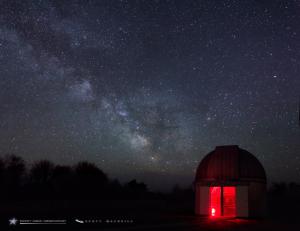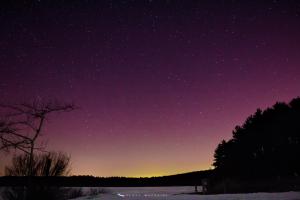
Public Stargazing - CLOSED
- Where:
- Frosty Drew Observatory
- When:
- Friday March 20, 2015 CLOSED
- Cost:
- $1 Suggested Donation per Person
Tonight's forecast is calling for clouds with measurable amounts of snow fall. This is rather unfortunate as the New Moon takes place today leaving fabulously dark skies to revel in. Due to severe winter conditions on site, Frosty Drew Observatory will remain closed tonight. We will return to our regular Stargazing schedule on March 27th. Follow us on Twitter or Facebook for updates on happenings at Frosty Drew. Happy first day of Spring New England!
-------------------------------------------------------------------------
Weekly Happenings
Scott MacNeill
At 6:45 p.m. EDT tonight, the Ecliptic – which is the path the Sun takes across the sky, will intersect with Earth's celestial equator. At this point the Vernal Equinox will take place marking the first day of Spring. Yay, snowstorm for Southern New England on first day of Spring! At the point of Equinox, Earth will neither be inclined towards or away from the Sun. This will result in the Sun being directly overhead (at zenith) on the equator. Additionally, the Sun will rise and set at the same time for corresponding locations in the Northern and Southern Hemispheres. So step out tonight in winter storm conditions with temps in the upper 20's and welcome Spring.
This past week, skies from mid latitudes to the polar regions lit up with a spectacular light show of epic proportions as the Northern Lights made one of their best appearances in recent memory. Resulting from a huge X2 class solar flare on the Sun, which was followed up by two massive coronal mass ejections (CME), all Earth directed. On St. Patricks Day (March 17), NOAA started sending out alerts that a massive G4 level geomagnetic storm was under way, quickly becoming the most intensive geomagnetic storm of the current solar cycle!
Geomagnetic storms happen when billions of tons of plasma eject from the Sun, usually in the form of a CME. The plasma storm has its own magnetic field and travels with the solar wind. Once arriving at Earth, plasma and magnetism bombard Earth's magnetic field effectively peeling back layers of the magnetosphere. This will allow charged particles to drop into Earth's ionosphere exiting particles in the atmosphere.
As the massive G4 storm progressed, amazing photographs started pouring in from all over the world. Many arctic latitude aurora photographers proclaimed sites never seen before in the Aurora Borealis. We set out at Frosty Drew to try and capture any mid-latitude aurora visible in Rhode Island. Though the aurora were hardly naked eye visible, we were able to capture the faint glow of the Northern Lights with our cameras. Check out some of the unbelievable photos from around the globe of the St. Patty's Day Auroras at http://spaceweathergallery.com/aurora_gallery.html
-Scott


